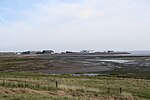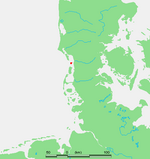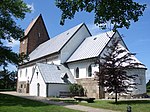Rømø
Danish Wadden Sea IslandsGeography of Tønder MunicipalityIslands of DenmarkRømø

Rømø (German: Röm, North Frisian: Rem) is a Danish island in the Wadden Sea. Rømø is part of Tønder Municipality. The island had 650 inhabitants as of 1 January 2011, and covers an area of 129 km². Rømø is the southernmost of Denmark's Wadden Sea Islands. This distinction was previously held by the small uninhabited island of Jordsand, which sank in 1999.
Excerpt from the Wikipedia article Rømø (License: CC BY-SA 3.0, Authors, Images).Rømø
Småfolksvej, Tønder Municipality
Geographical coordinates (GPS) Address Nearby Places Show on map
Geographical coordinates (GPS)
| Latitude | Longitude |
|---|---|
| N 55.133333333333 ° | E 8.5166666666667 ° |
Address
Småfolksvej
Småfolksvej
6792 Tønder Municipality
Region of Southern Denmark, Denmark
Open on Google Maps










